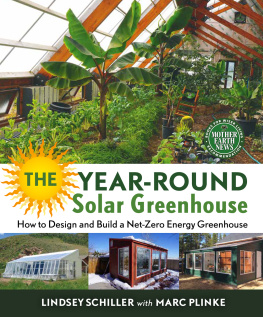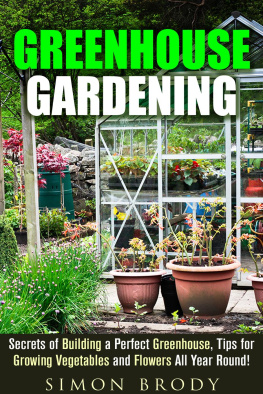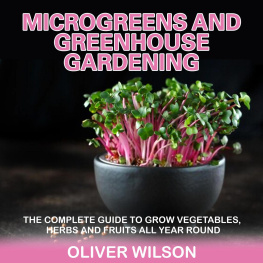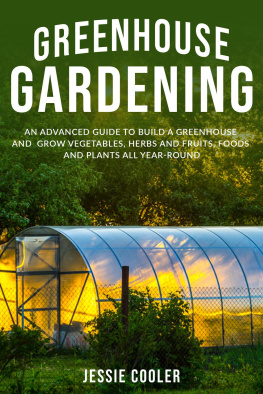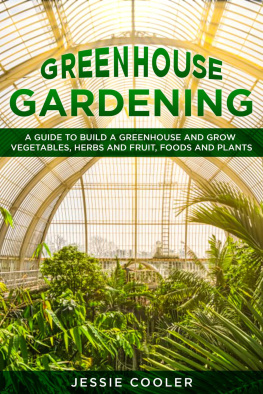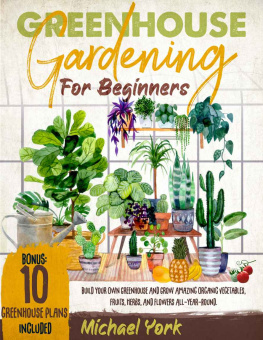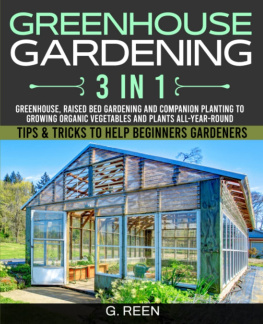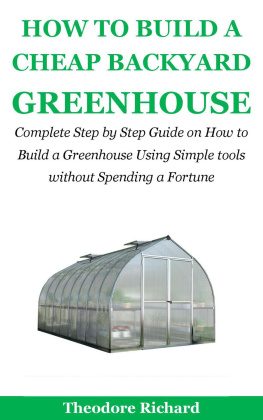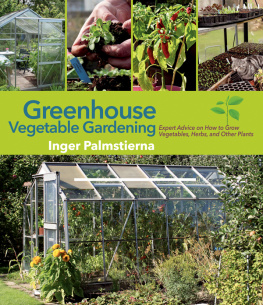Praise for
The Year-round Solar Greenhouse
Particularly for aquaponics growers, solar greenhouse design is a nobrainer. Schiller and Plinke have created a practical, easy to read guide that enables anyone to design and build their own sustainable, year-round greenhouse. I highly recommend it for aquaponic growers, and any gardener looking to extend their season.
Sylvia Bernstein, author, Aquaponic Gardening
Schillers book is an important resource that will help farmers and greenhouse operators leverage innovation for sustainable and profitable food production. I believe that agricultural innovation for economic and ecological sustainability is the most important opportunity facing humanity, and this book should be part of your tool kit.
Gaelan Brown, author, The Compost-Powered Water Heater
Year-round food production in the emerging post carbon society will require solar greenhouses at many scales. Whether an attached home greenhouse or large commercial bioshelter, successful long term food production in these bio-structures requires artful design, careful planning, quality construction and carefully integrated systems of light, heat, ventilation and well managed growing spaces. Lindsey Schiller and Marc Plinke have provided an essential tool to ensure success in all these areas. This book is extensively researched, written with personal experience and full of essential facts and figures rendered simple and accessible.
Darrell E. Frey, author, The Bioshelter Market Garden
The Year-Round Solar Greenhouse is an invaluable primer for anyone looking to grow their own food year-round without fossil fuels. The science and methods are well explained, meticulously documented, and easy to understand. A great resource!
Dan Chiras, author, Power from the Sun, Chinese Greenhouses, and The Homeowners Guide to Renewable Energy
Well researched and thorough, its a contribution of her effort to convey to us all the information on the subject. The author is educated and writes in a manner easily understood, and to the point. She has done us all a favor with this book. Each chapter ends with a summary takeaways that gives extra reading references, books, CDs etc. covering all related topics for whatever your particular need may be. What you need to learn about solar green houses you WILL find by starting with this book!
Leslie Jackson, co-author, Rocket Mass Heaters
Copyright 2016 by Lindsey Schiller. All rights reserved.
Cover design by Diane McIntosh.
Cover photos: bottom left Penn and Cord Parmenter, Smart Greenhouses LLC
Top photo of Golden Hoof Farm greenhouse, Lindsey Schiller/
Ceres Greenhouse Solutions
Sun element iStock
All others Lindsey Schiller/Ceres Greenhouse Solutions
Printed in Canada. Second printing March 2017.
Inquiries regarding requests to reprint all or part of The Year-Round Solar
Greenhouse should be addressed to New Society Publishers at the address below.
To order directly from the publishers, please call toll-free (North America)
1-800-567-6772, or order online at www.newsociety.com
Any other inquiries can be directed by mail to:
New Society Publishers
P.O. Box 189, Gabriola Island, BC V0R 1X0, Canada
(250) 247-9737
LIBRARY AND ARCHIVES CANADA CATALOGUING IN PUBLICATION
Schiller, Lindsey, 1987-, author
The year-round solar greenhouse : how to design and build a net-zero
energy greenhouse / Lindsey Schiller with Marc Plinke.
Includes index.
Issued in print and electronic formats.
ISBN 978-0-86571-824-1 (paperback).ISBN 978-1-55092-618-7 (ebook)
1. Solar greenhouses. 2. Solar greenhousesDesign and construction.
3. Solar greenhousesHeating and ventilationHandbooks, manuals, etc.
4. Greenhouse gardening. 5. Solar energyPassive systems. I. Plinke, Marc, author II. Title.
SB415.S35 2016 690.8924 C2016-905437-3
C2016-905438-1

New Society Publishers mission is to publish books that contribute in fundamental ways to building an ecologically sustainable and just society, and to do so with the least possible impact upon the environment, in a manner that models that vision.

Contents
Introduction
The snow is shin deep, the mercury well below freezing. In the stunning clarity of winter sunshine, a complex triangle of glass rises from among the dazzling white drifts. A layer of condensation obscures the details of the verdant world inside, but as I draw closer, the green takes shape: a forest of kale, hanging baskets of alyssum, beguiling arch of pole beans. Hyacinths float atop vats of greenish water, as catfish swim in lazy circles.
In contrast with the cold, white world I just stepped out of, this winter landscape feels like paradise. As I quickly shed layers, my muscles release their frigid tension and my face relaxes into a smile. The air is humid, teeming with the sweet smell of soil, of respiring plants, of life.
Elise Hugus,
The Cape Cod Ark: A Study in Self-Sufficiency,
Edible Cape Cod
Winter, 2014.
In the winter of 2011, I went out to see a bizarre-looking structure on a farm in East Boulder, Colorado. The building was a prototype net-zero-energy greenhouse funded by the Colorado Department of Agriculture, but except for some glass, it bore little resemblance to a greenhouse. Wood boards, acting as light reflectors, protruded from the front. A sharply peaked sawtooth roof reflected light down to the plants inside. Moveable boards of insulation opened and lowered between panes of windows.
Standing in the humid room teeming with vegetables, I saw a spectacled man shuffling along the wall. He occasionally stopped to plug in his Macbook into various gadgets. Hes just getting data, the tour guide explained with a wave. It was a brief moment but one I remember well as a marker when life took a different direction.
The data-collecting gentleman was Marc Plinke, who would turn out to be my business partner and co-author. In a follow-up meeting over coffee, we discussed the experimental greenhouse, the potential for the design and technology, and future business aspirations. We were in the same mindset, and a few months later we started a business to test and refine the concepts and make energy-efficient, sustainable greenhouses available to a wider market. We named it Ceres Greenhouse Solutions after the Roman goddess of agriculture, inspired by an image of an unruly-haired goddess I saw a few months earlier on European currency. As a business, Ceres has provided an incredible vehicle in which to research and apply new ideas to net-zero-energy greenhouses. It has been an incubator that allowed us to tweak and improve designs with every iteration, exploring and developing new ways to store and transfer the heat of a greenhouse.
Much of our development effort went into a type of ground-to-air heat exchanger we call a Ground-to-Air Heat Transfer (GAHT) system, which stores excess daytime heat from the greenhouse in the soil underground. Weve worked to simplify the GAHT system, making it more cost-effective and easy to install and recorded huge quantities of data to improve their efficiency. Weve designed and installed hundreds of GAHT systems all over the world (from Sweden to Brunei), in growing operations large and small, demonstrating the universal applicability of the system.
Next page
